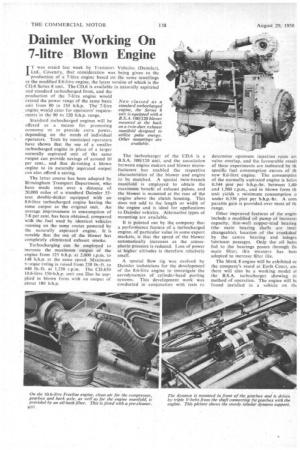Daimler Working On 7-litre• Blown Engine
Page 44

Page 45

If you've noticed an error in this article please click here to report it so we can fix it.
Standard turbocharged engines will be offered as a means for promoting economy or to provide extra power, depending, on the needs of individual operators. Tests by municipal operators have shown that the use of a smaller turbocharged engine in place of a larger naturally aspirated unit of the same output can provide savings of around 10 per cent., and that de-tuning a blown engine to its naturally aspirated output can also afford a saving.
The latter course has been adopted by Birmingham Transport Department, who have made tests over a distance of 20,000 miles of a standard Daimler 55seat double-decker equipped with an 8.6-litre turbocharged engine having the same output as the original unit. Art average improvement in consumption of 7-8 per cent. has been obtained, compared with the fuel used by identical vehicles running on the same routes powered by the naturally aspirated engine. It is notable that the use of the blower has completely eliminated exhaust smoke.
Turbocharging can be employed to increase the maximum output of the engine from 125 b.h.p. at 2,000 r.p.m. to 148 b.h.p. at the same speed. Maximum t....:rqtie rating is raised from 258 lb.-ft. to 440 lb.-ft. at 1,250 r.p.m. The CD.650 10.6-litre 150-b.h.p. unit can riso be supplied in blown form with an output of about 180 b.h.p.
The turbocharger of the CD.6 is a B.S.A. 100/120 unit, and the association between engine makers and blower manufacturers has enabled the respective characteristics of the blower and engine to be matched. A special twin-branch manifold is employed to obtain the maximum benefit of exhaust pulses, and the blower is mounted at the rear of the engine above the clutch housing. This does not add to the length or width of the engine and is ideal for applications to Daimler vehicles. Alternative types of mounting are available.
It is pointed out by the, company that a performance feature of a turbocharged engine, of particular value in some -export markets, is that the speed of the blower automatically increases as the atmospheric pressure is reduced. Loss of power at higher altitudes is therefore relatively small.
A special flow rig was evolved by Daimler technicians for the development of the 8.6-litre engine to investigate the aerodynamics of cylinder-head porting systems. This development work was conducted in conjunction with tests to determine optimum injection rates am valve overlap, and the favourable result of these experiments are indicated by th specific fuel consumption curves of th new 8.6-litre engine. The consumptiol of the normally aspirated engine is belcn 0.344 pint per b.h.p.-hr. between 1,40 and 1,500 r.p.m., and in blown form th unit yields a minimum consumption o under 0.336 pint per b.h.p.-hr. A corn parable gain is provided.over most of th range.
Other improved features of the engin, include a modified oil pump of increaset capacity, thin-wall copper-lead bearing (the main bearing shells are inter changeable), location of the crankshal by the centre bearing and integra lubricant passages. Only the oil bein fed to the bearings passes through th. main filter: this measure has beet adopted to increase filter life.
The Mark 8 engine will he exhibited or the. company's stand at Earls Court. an; there will also be a working model o' the B.S.A. turbocharger showing in method of operation. The engine will bt found installed in a vehicle on tit(
Northern Counties stand. the vehicle being a Daimler CVD.6-30 69-scat doubledecker destined for the West Bromwich Corporation fleet.
New vehicles on the Daimler stand will include the CVD.650-220 export chassis, having a wheelbase of 22 ft., which is designed to accommodate a 36-ft. body. A vertical engine is employed in preference to an underfloor type in the interests of easy maintenance, and detailed features have been introduced to give the same advantage. A special spare-wheel lifting gear is fitted to reduce to a minimum the space occupied below the rear overhang of the chassis, which is about 10 ft.
An interesting feature of the Freeline Show model is a multi-purpose oil-bath filter which is connected to the compressor intake, the gearbox and back axle as well as to the engine manifold. A coarse honeycomb radiator is employed in preference to a tube type, and extra cooling is supplied by a 6-gal. circulating tank.
Other Show models will comprise a modified CSD.6-30 doubledecker chassis equipped with a Series 8 engine and a David Brown SP.450 allsyncbromesh four-speed gearbox With Porsche synchronizers. A CVG.6-30 double-decker will be seen fitted with a Daimatic semi-automatic gearbox and a Metropolitan-CammellWeymann 73-seat body.




























































































